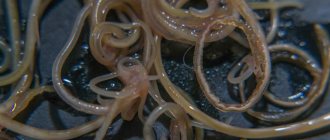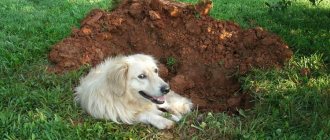Human food
Just because a food is good for us doesn't mean it's safe for dogs. Chocolate contains large amounts of caffeine and theobromine, which dogs do not tolerate very well. This can lead to various disorders ranging from gastrointestinal, heart, blood pressure disorders and several others. All other things being equal, dark chocolate is more toxic. The toxic dose is calculated using the dog's weight, the type of chocolate, and the amount of chocolate the dog ingested. Be sure to contact your veterinarian and tell him this information so that he can advise you on what steps to take. It is often recommended to induce vomiting if food has been eaten within the last two hours. If poisoning is severe, your dog should be hospitalized and placed on a drip. Chocolate is generally the most common cause of poisoning, but there are others.
Grapes and raisins can cause acute kidney failure; macadamia nuts can lead to gastrointestinal upset, tremors and weakness. Avocado can cause vomiting and diarrhea. Sugar-free gum contains xylitol, which can cause dangerously low blood sugar. Signs of low blood sugar include weakness, loss of coordination, tremors and seizures. Because human food is generally fattier and spicier, dogs that overeat regular human food tend to suffer from gastrointestinal distress, which in severe cases leads to inflammation of the pancreas. Never allow your dog to eat your regular food, and always inform your friends and guests about this!
Rodenticides (poisons for rodents)
Mice and rat bait is made to be palatable to them, but unfortunately, a dog may find the bait edible for the same reason. Until now, many such baits are made on the basis of an anticoagulant, which blocks vitamin K and leads to massive internal bleeding and death of any rodent. Dogs experience the same bleeding, but because dogs are larger, without treatment, death usually occurs after 3-5 days. If your dog has recently ingested poison, induce vomiting as soon as possible and seek veterinary attention. Your veterinarian will give your dog vitamin K and you will need to monitor him for lethargy, weakness, and loss of appetite for 2-3 weeks. If you notice any of these symptoms, contact your veterinarian immediately. In exceptional cases, the dog may require a blood transfusion.
However, there are other types of baits. Cholecalciferol-based baits increase the level of calcium and phosphorus in a dog's blood, causing kidney damage. The dog will require urgent hospitalization and an IV to reduce calcium and phosphorus. There is another poison, bromethalin, which affects the brain. The dog experiences tremors and seizures, and eventually death. Of the three types of poisons, this is the most dangerous and difficult to treat. Therefore, if you have any rodent problems, only use anticoagulant-based rodenticides as they are the least toxic and easiest to treat. Place the bait in an area where your dog cannot get into it, and check the bait once or twice a day. If the rodent problem is resolved, dispose of the baits properly. If you spot dog tracks on the bait, seek veterinary help immediately.
Do not throw away the poison package and, if necessary, bring it with you to the veterinarian. With the help of this package, the doctor will be able to determine the type of poison and prescribe the appropriate treatment, since, unfortunately, there are cases when the doctor prescribes the wrong treatment due to the lack of all the necessary information.
When dogs are no different from rats
Until all the media taught anyone and everyone how to prepare poison from a medicine for tuberculosis, most often dogs were poisoned with poisons intended for rats. Such troubles still happen now, so you shouldn’t forget about them: everyone is equal before strychnine.
Rat poison and insecticides may contain arsenic (symptoms of poisoning: loss of appetite, extreme thirst, signs of abdominal pain, vomiting, diarrhea, rapid breathing and loss of consciousness). No more useful is phosphorus from rat poison and the same insecticides. Poisoning with it is not detected immediately, sometimes several days pass before symptoms appear: extreme anxiety, abdominal pain, vomit is greenish-brown in color and glows in the dark, swollen tongue, yellowness, general weakness.
If a dog ingests strychnine poison intended for rats, spasmodic muscle twitching, convulsions, and inability to stand occur. The jaws are closed, the eyes are bulging, the head and tail are extended upward. Repeated convulsions lead to death.
DDT is found in flea and bedbug powders and, in addition to the general symptoms of poisoning, causes muscle cramps.
Dog mortality from poisoning with poisons for rats and insects is about 90%, mainly due to late contact with a doctor and unclear symptoms, which complicate diagnosis.
When the first signs of poisoning appear, the dog is advised to give activated charcoal 1-3 grams. per 1 kg of weight and immediately consult a doctor. The minutes count down. In case of such poisoning, dog breeders also advise keeping the drug “Konakion” (vitamin K) with you.
Insecticides (bug repellents)
The most common insecticide that dogs ingest is cockroach killer. They contain an attractant that is similar to peanut butter and which attracts dogs. Fortunately, the insecticides used today are practically non-toxic to mammals or their dosage in baits is very small. However, there is another danger, namely the container of poison, since the dog can swallow it whole. Therefore, when placing poison, you need to follow the same rules as in the case of rodenticides.
Medicines
This category includes various drugs intended for use in humans. Ibuprofen and paracetamol are poisonous to your dog and you should never give them to your dog. Keep all your pills out of your dog's reach. Various bottles and mixtures may not be accessible to children, however, many of them remain accessible to the dog. If possible, take the pills in the bathroom with the door closed so that if you accidentally drop the pill, your dog won't be able to catch it and swallow it. If your dog ingests a tablet or shows signs of poisoning, contact your veterinarian immediately and give him details of the ingested medication so he can determine the next steps you will need to take.
How to save your dog and whose side is the law?
Dog handlers and dog hunters agree on one thing: in order to be poisoned, the dog must eat bait, and a rather large one, 50-100 grams, with tablets contained there. This is a whole cutlet or sausage, and the owner will notice if a dachshund on a leash swallows this. Even if it is not poisoned bait, but simply unknown garbage, you should still be concerned and induce vomiting (for example, by drinking saline solution).
“The dogs of two of my friends in St. Petersburg recently died,” said Elena Tipikina. “Despite the news that dogs were being poisoned in the city, they walked without leashes or muzzles. This is called the connivance of the owners. The dogs ate something, and after 30-40 minutes they began to have convulsions.
Dog breeder Elena Tipikina is sure that the dog must be taught not to pick up anything from the ground.
– People have problem dogs, and they shift the responsibility to dog hunters, who write in plain text: put on muzzles and fasten leashes. Even a dachshund, if it picks up from the ground, needs to be muzzled, or the dog needs to be trained.
However, in Russia there is no national law regulating the rules of dog walking. If your dog causes serious harm to another person, you will be punished for causing that harm through negligence, i.e. in the worst case, arrest for up to 6 months in accordance with paragraph 1 of Art. 118 of the Criminal Code of the Russian Federation. In Moscow, the rules for keeping animals are determined by Chapter 5 of the Moscow City Code on Administrative Offences, “Administrative Offenses in the Field of Treatment of Animals.” In Moscow, you cannot visit shops, playgrounds, markets, beaches with a dog without a leash and muzzle, or be on public transport. It is prohibited to walk dogs on the territory of healthcare institutions, kindergartens, schools and other educational institutions that work with minors. It is prohibited to appear with a dog without a leash in natural and green areas. Violations are punishable by a fine of one to two thousand rubles.
From the point of view of Elena Tipikina, the media is not least to blame for the increasing poisoning of domestic dogs. After they showed everywhere how to prepare poison, mentally unstable people started doing it.
“All the scared athletes - runners and cyclists, parents of small children and angry grandmothers, the whole country knows what medicine to buy and what to wrap it in to poison the neighbor’s dog and rob his barn,” Elena Tipikina is indignant. – In the garden of the Academy of Arts in St. Petersburg, dogs were poisoned by a seriously ill girl: as a child she was bitten by dogs, since then she has hated and poisoned them, and she will not be sent to prison - she is mentally ill. Over the course of a few days, she poisoned six large purebred dogs walking in that garden, and none of the owners thought about their own guilt in the fact that their dog was walking without a muzzle. I live and don’t know from what corner a Rottweiler without a muzzle and a leash will jump out at me. And they explained to people through the media that the law in Russia does not work in either direction: neither dog breeders, whose animals scare you while jogging in the park, and your children on the playground, will not be able to be forced to put on muzzles, nor if you poison someone else’s dog, you Nothing will happen.
Lawyer retired Ministry of Internal Affairs Colonel Evgeny Chernousov claims that not a single case of animal poisoning has yet been opened in Moscow.
If the poisoners are caught and proven that they killed the dogs, they will be charged under Article 245 of the Criminal Code (“Cruelty to Animals”), the maximum penalty for which is two years in prison. However, dog breeders say, the police are in no hurry to accept statements under this article. The owner of a poisoned dog can count on prosecution of those responsible only under the article “Damage of property.” Basically, dog breeders try to indicate in the statement that the scattered poison posed a danger to humans - for example, it was scattered near a playground, where a child could pick it up.
In recent years, there have also been cases of poisoning of small dogs with deicing agents. Winter has already arrived, and owners are advised to remember that short dogs need to be carried through areas covered with reagents, and after coming home, wash their paws thoroughly.
– Normally, the reagents are not poisonous, but they could, for example, be stored in the same warehouse with toxic substances. Poisoning with reagents proceeds differently than poisoning with anti-tuberculosis tablets, and usually the dog can be helped, explained Elena Tipikina.
Veterinary medicinal products
Many tablets that veterinarians prescribe for dogs have a pleasant taste, causing dogs to consider them a treat. It is important that all your dog's medications are kept in a safe place. If you're giving your dog medication, make sure you know the exact dosage and schedule, so before you leave your veterinarian's office, be sure to ask your veterinarian these questions. Never use flea and tick products for dogs on your cats, as these products for dogs and cats are fundamentally different.
Various chemicals
Antifreeze is very sweet and attracts many dogs. After consuming even a small amount of antifreeze, the dog becomes very drunk. However, after a few hours the dog will be sober and quite normal, but after a few days he will definitely experience kidney failure. The toxic component in antifreeze is ethylene glycol. There is an antidote for it, but it must be used immediately after consuming antifreeze, so if you suspect your dog has consumed it, seek veterinary attention immediately. Antifreeze based on propylene glycol is much less toxic, so if possible, buy it. Besides antifreeze, there are many other chemicals that pose a risk to all pets. These are substances such as paints, paint thinners, and pool chemicals. If a product is labeled as “poisonous,” be aware that it is also poisonous to animals and keep such products out of reach.
Be proactive and have an emergency first aid kit ready for your dog. In addition to the basic supplies that should be in the first aid kit, do not forget to put in it a 3% solution of hydrogen peroxide and a small syringe, with which you can induce vomiting in the dog. Also, do not forget to add saline solution to rinse the animal's eyes if necessary. And of course, always have your veterinarian's number and emergency medical number handy.
And remember that prevention is the best cure!
How dog hunters poison dogs - what a pet owner needs to know
The doghunter movement (literally translated as “dog hunters”) originated just over a decade ago. The reason for it was the inaction of the authorities regarding stray dogs. Programs for catching, sterilizing and socializing animals turned out to be ineffective, which caused dissatisfaction among many.
According to dog hunters, stray dogs are dangerous to people. The goal of the “hunters” is to protect society from aggression and diseases of stray dogs.
Hunters believe that the only correct and effective way is physical destruction - murder. The methods used by dog hunters are far from humane.
Often the consequences of poisoning can be observed by passers-by and small children. For impressionable people this is a terrible sight.
What do dog hunters use?
The simplest and cheapest method of killing used by hunters is poisoning. At the same time, contact with the animal is minimized, sometimes completely eliminated.
Street dogs often look for food near garbage cans, at the entrances of residential buildings, in parks, which dog hunters take advantage of by scattering poisoned food in places where animals are likely to appear.
Poison is added to minced meat, sausages, sausages - a hungry dog cannot resist such a find or will trustingly accept poison from the hands of the poisoner.
What do dog hunters poison dogs with? Medicines are used that are used to treat people, but are deadly for dogs, poison for rodents and chemical reagents that are also dangerous for human health. Often the victims of hunters are domestic dogs that grab a tasty morsel on the street.
Isoniazid
Medicine in tablets, anti-tuberculosis antibiotic. You can buy it in almost every pharmacy without a prescription.
It is popular among dog hunters as a cheap and reliable remedy - for dogs, isoniazid poisoning is fatal in almost 100% of cases.
To be sure, hunters can add an antiemetic to the drug, making it impossible to empty the stomach and hastening death.
Signs of isoniazid poisoning appear 30-40 minutes after the substance enters the body:
- the animal becomes drowsy and apathetic,
- the dog loses coordination, its paws cannot hold it,
- after 60-90 minutes, uncontrollable vomiting, convulsions,
- difficulty breathing,
- after 3-5 hours death occurs from suffocation.
Digitalis (digoxin)
A drug for people with heart failure that stimulates the work of the heart muscle. A large dose of the active substance causes disruption of the heart, leading to death. Symptoms of intoxication:
- general weakness,
- severe vomiting
- diarrhea,
- severe arrhythmia,
- heart failure.
When the first signs of poisoning appear, try to induce vomiting in the animal, give an absorbent (activated carbon, enterosgel). Try to get to the clinic as quickly as possible.
Atropine
Hunters add atropine sulfate powder to minced meat. It has a depressant effect on the nervous system. The dog's pupils dilate and there is intense thirst. The dog may bark hoarsely. The pulse quickens, convulsions begin, and coma sets in. Without emergency medical assistance, all reflexes fade away, and death occurs within 6-12 hours.
Emergency aid is gastric lavage. You can give an absorbent and immediately go to the veterinary clinic.
Cyanide
All derivatives of hydrocyanic acid are extremely poisonous. Potassium cyanide, sodium and calcium, cyanide are potent substances used in agriculture (pesticides and pesticides) to treat plants against pests, to control weeds and rodents. In high concentrations they are extremely dangerous for both animals and humans.
The danger of cyanide poisoning is that it occurs in an acute form. Signs appear simultaneously with the onset of an irreversible process:
- cerebral hypoxia develops rapidly,
- tissue asphyxia occurs,
- paralysis of the central nervous system develops,
- convulsions begin.
Rapid deterioration of the animal's condition requires immediate medical attention. The dog needs emergency therapy with special drugs that are not available for purchase at pharmacies (in particular Methylene blue), as well as cardiopulmonary resuscitation. If treated within 30 minutes of the onset of symptoms, the dog has a chance of survival.
Arsenic
Arsenic and its compounds in large doses cause severe poisoning. The first signs in an animal appear within 30-60 minutes after the toxic substance enters the body:
- the dog continuously rubs its face with its paws,
- the barking becomes hoarse, then silent,
- severe bouts of vomiting begin,
- diarrhea,
- convulsions.
Rat poison
There are several types of rat poison. The easiest and most treatable poisoning is with drugs containing anticoagulants (substances that prevent blood clotting). Symptoms appear on day 2:
- the animal is weak, apathetic,
- shortness of breath develops,
- the surface of the mucous membranes, tongue turns pale,
- nosebleeds appear, gums may bleed,
- blood may appear in stool and urine,
- the dog refuses food.
Timely seeking help and a correct diagnosis can save 85% of dogs.
In case of zinc phosphide poisoning, the development of symptoms occurs faster and the course of the disease is more severe. Within 2-3 hours after consuming the poison, the dog begins to vomit violently, diarrhea, shortness of breath, and convulsions appear.
Breathing becomes difficult and the pet may lose consciousness. Nevertheless, the prognosis is favorable.
In most cases, timely medical care and proper treatment lead to a complete recovery of the animal.
Other poisons and drugs
Dog hunters also use other, less common means, such as: extracts from poisonous plants and mushrooms, iron sulfate, saltpeter, strychnine, potent sleeping pills, chemical reagents for developing films. They even add broken glass, which is not visible on x-ray, to the bait. Only specialists can correctly identify a toxic substance and provide qualified assistance.
How to provide first aid?
If you are sure that the dog could not have gotten food poisoning at home (expired food, stale porridge or milk), but the animal became ill, these may be symptoms of dog poisoning by dog hunters.
First aid will be effective if the dog has eaten something in front of the owner. In this case, a minimum of time will be spent on making a diagnosis, the symptoms will be correctly interpreted and immediate action can save the dog.
- Usually the pet owner can only guess what poisoned the dog. Therefore, if signs of poisoning increase, you should immediately contact a veterinarian . Sometimes the minutes count.
- Inducing vomiting and clearing the stomach of poison makes sense only in the first minutes, when the pet has eaten something suspicious in front of the owner, and until the poison is absorbed into the blood. Mix 3% hydrogen peroxide with water (1 to 1) and pour it into the dog’s mouth with a syringe without a needle at the rate of 1-2 ml per kilogram of animal weight. In a few minutes you will receive the contents of your stomach. You cannot induce vomiting if several hours have passed since the poisoning; this is an unnecessary waste of time. It is also dangerous when the animal has convulsions, paralysis, or loses consciousness.
- If you induce vomiting in a dog, do not put your hands in its mouth . An unconscious dog can reflexively clench its jaw, leaving you without fingers. In addition, you yourself risk getting severe poisoning from the remnants of the poison.
- If there are symptoms of isoniazid intoxication, the first thing you need to do is inject the animal with 5-6 ampoules of vitamin B6 (pyridoxine), an overdose is not dangerous, it is better to inject more than not enough.
Prevention of poisoning by dog hunters
Only you can ensure the safety of your pet. By following simple rules, it is possible to eliminate or minimize the possibility of dog poisoning:
- Commands "fu" and "no". Train and teach your dog to know and follow basic commands, especially those that can save his life. The animal must know that it is forbidden to pick up anything on the street, and it is also prohibited to take anything from strangers without permission.
- If your pet is walking without a leash, do not let him out of sight. Even when he grabs something, you always have time to react.
- Do not walk near garages, landfills, or vacant lots—where stray animals live en masse.
- If your pet regularly turns on the “vacuum cleaner” mode and there is no way to wean it off, a muzzle will be the solution. A thick leather, plastic or metal accessory will not allow him to pick up anything from the ground, and you will be calm about his health.
- Always have a first aid kit (at least hydrogen peroxide solution and vitamin B6) and veterinary clinic contacts on hand.
It should be remembered that cats are also in danger. What are cats poisoned with? The same drugs and substances as dogs. Poison baits attract all animals equally, and they all need our help equally.
Source: https://rvdku.ru/otravleniya/chem-travyat-sobak-doghantery-chto-nuzhno-znat-hozyainu-pitomcza











